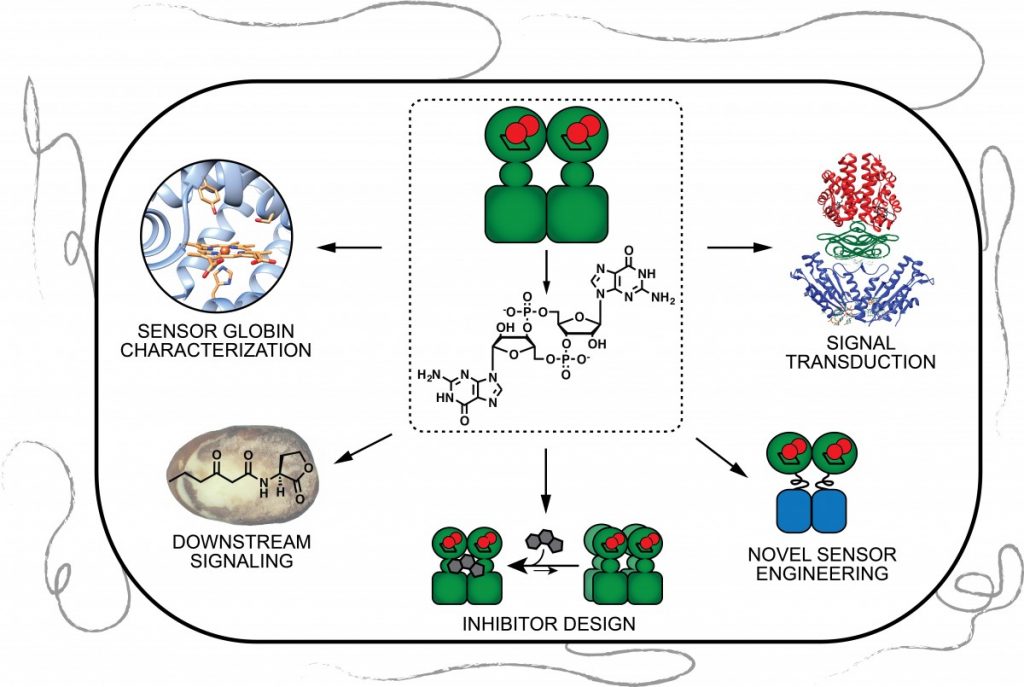
Oxygen (O2) is an important environmental signal that must be sensed by bacteria due to its key role in respiration for aerobic and facultative anaerobic bacteria, as well as its toxicity to obligate anaerobes. Furthermore, O2 levels vary significantly within the environment and the human host, serving as a signal for the bacteria to alter growth phenotypes and virulence. Therefore, my group is working to understand a family of putative O2 sensing heme proteins, termed globin coupled sensors (GCSs). The major goals of the project are to to elucidate signal transduction mechanisms within the GCS family and identify downstream pathways/proteins controlled by GCS signaling. GCS proteins are widely distributed throughout bacteria and contain a sensor globin domain linked to an output domain that can regulate diverse functions, such as aerotaxis and biofilm formation.
To date, our studies have characterized diguanylate cyclase-containing GCSs, including the proteins from Bordetella pertussis (BpeGReg), causative agent of whooping cough, and Pectobacterium carotovorum (PccGCS), a plant pathogen that causes rotting of numerous agriculturally relevant crops, as well as a GCS from Vibrio brasiliensis that is involved in stress sensing. These studies have improved our understanding of the enzymatic and conformational changes that accompany O2 binding, and the features of the heme pocket that transmit the O2 binding signal. In addition, we have recently discovered that O2-dependent GCS signaling in P. carotovorum controls motility, virulence factor production, and rotting of a plant host, linking GCS signaling to bacterial pathogenesis.
Papers related to the GCS project:
Research Features. (2018) Cracking the Communication Code of Bacteria. 123, 46-49.
Walker, J.A.; Rivera, S.; Weinert, E.E. (2017) Mechanism and Role of Globin Coupled Sensor Signaling. Adv. Microb. Physiol. 71, 133-169. DOI: 10.1016/bs.ampbs.2017.05.003
Burns, J.L.; Jariwala, P.B.; Rivera, S.; Fontaine, B.M.; Briggs, L.; Weinert, E.E. (2017) Oxygen-Dependent Globin Coupled Sensor Signaling Modulates Motility and Virulence of the Plant Pathogen Pectobacterium carotovorum. ACS Chem. Biol. 12, 2070-2077. DOI: 10.1021/acschembio.7b00380
Burns, J.L.; Rivera, S.; Deer, D.D.; Joynt, S.C.; Dvorak, D.; Weinert, E.E. (2016) Oxygen and c-di-GMP Binding Control Oligomerization State Equilibria of Diguanylate Cyclase-Containing Globin Coupled Sensors. Biochemistry. 55, 6642-6651. DOI: 10.1021/acs.biochem.6b00526
Rivera, S.; Burns, J.L.; Vansuch, G.E.; Chica, B.; Weinert, E.E. (2016) Globin Domain Interactions Control Heme Pocket Conformation and Oligomerization of Globin Coupled sensors. J. Inorg. Biochem. 164, 70-76. DOI: 10.1016/j.jinorgbio.2016.08.016
Jia, X.; Wang, J.-b.; Rivera, S.; Duong, D.; Weinert, E.E. (2016) An O2-sensing stressosome from a Gram-negative bacterium. Nature Commun. 7, 12381. DOI: 10.1038/ncomms12381
Burns, J.L., Deer, D.D., Weinert, E.E. (2014) Oligomeric State Affects Oxygen Dissociation and Diguanylate Cyclase Activity of Globin Coupled Sensors. Mol. BioSyst. 10, 2823-2826. DOI: 10.1039/c4mb00366g